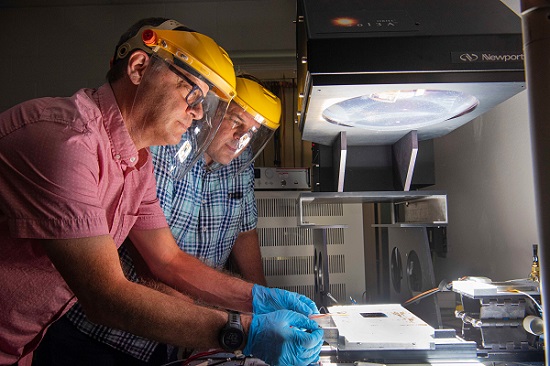Sandia National Laboratories will lead a center to improve the understanding of perovskite-based photovoltaic technology and determine the best tests to evaluate the lifetime of the new solar panels. The effort is funded by the Department of Energy (DOE), which recently awarded Sandia $14 million to form the Perovskite Photovoltaic Accelerator for Commercializing Technologies Center.
The efficiency of perovskite-based solar cells has reached 25%, approaching the levels of common crystalline silicon-based solar cells. Perovskite solar cells use common starting materials and can be produced at much lower temperature using more standard methods, said Joshua Stein, a Sandia systems engineer and director of the new center. This means perovskite-based solar panels have the potential to be significantly cheaper and less energy-intensive to manufacture compared with silicon solar cells.
However, perovskite-based photovoltaic technologies still have several challenges to overcome before they can compete against conventional solar panels.

Joshua Stein (left), a Sandia National Laboratories engineer and director of a new Perovskite Photovoltaic Accelerator for Commercializing Technologies Center, and Charles Robinson, a Sandia technologist, examine a solar module. The new center will determine the best performance and reliability tests for perovskite solar modules. Courtesy of Randy Montoya/Sandia National Laboratories.
“If we want to meet the U.S.’s goals of increasing the amount of power from renewable energy, we’re going to need a lot more manufacturing capacity,” Stein said. “Perovskite photovoltaic technologies may provide a pathway to low-cost manufacturing, but there is still much that is unknown about this technology, especially in terms of outdoor performance and reliability. The center will field-test and monitor this technology using a common set of testing protocols so that every device can be fairly compared.”
The center, which also includes the National Renewable Energy Laboratory (NREL) and management consulting firm Black & Veatch, will serve as a neutral evaluator of technologies and companies and will have three primary focuses to help companies quantify and characterize risks related to performance, reliability, and bankability.
Perovskite solar cells can be made of a wide variety of chemicals and using numerous methods. This variability is a strength but can also make it challenging to compare the performance characteristics, such as energy efficiencies at different light conditions or operating temperatures. A solar cell is a small device that captures sunlight and converts it into electricity. A solar module is made up of multiple solar cells connected and integrated together.
“Right now, it’s like the Wild West,” said Stein, who has led the photovoltaic performance modeling collaborative for the past decade. “There are no established standards or test protocols for assessing perovskite solar modules. We would like to craft a clear set of test protocols that have been validated and vetted by the industry to create a rubric or set of goal posts, so that companies that are getting into perovskite solar technologies know what they need to do.”
Within the first year, the team wants to test at least 30 perovskite modules outside at Sandia’s Photovoltaic Systems Evaluation Laboratory and NREL. Eventually they hope to expand performance testing to at least 50 kW of perovskite-based photovoltaic modules and full systems.
The center also is focused on determining the reliability of
perovskite solar modules, or how they perform in the field over a long time and
how they begin to degrade, said Laura Schelhas, a research scientist and group
manager at NREL and deputy director of the center.
Researchers use accelerated testing protocols, such as exposing modules to high humidity or intense ultraviolet light or rapidly switching between hot daytime and cool nighttime temperatures, to “kind of look into the future and predict the long-term reliability of these panels in the real world without having to wait 30 years,” Schelhas said.
Another goal for the center is to show that tests conducted at NREL and CFV Labs, an Albuquerque, N.M.-based commercial photovoltaic testing lab and also part of the center, produce very similar results from identical solar modules. Stein said, “If you’re going to develop standards, you have to make sure that commercial companies can run those standard tests.”
The center will also support near-term and forthcoming development and commercial success.
“I see this center as a way for technology developers, who generally don’t have a strong commercial background, to receive invaluable guidance on what they need to achieve to be commercially successful,” said Ralph Romero, senior managing director of Black & Veatch’s bankability practice.
Within two years, the center aims to conduct bankability roadmaps for at least two perovskite-based photovoltaic companies. This will help them plot their paths to commercialization. By the fourth year, the center plans to conduct complete bankability assessments of at least two companies.